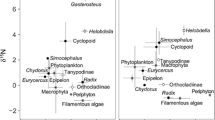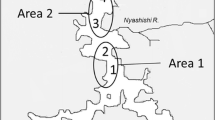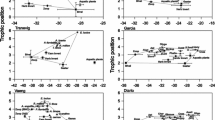Abstract
Body size is usually considered a good indicator of trophic position in fish communities. Indeed, the proverbial wisdom that “Big Fish Eat Little Fish” is consistent with observations from marine systems where systematic removal of the largest individuals has occurred, with cascading effect in the ecosystems. Trophic cascades are also well documented in temperate lakes but may not be as pronounced in (sub)tropical lakes due to higher degree of fish omnivory. We analysed fish communities along a climatic gradient and showed the classical correlation between body size and relative trophic position disappears in warmer climates where large fish appear to be feeding systematically on the lowest trophic levels. This concurs with experimental findings demonstrating that omnivorous fish tend to include more plant and less animal matter in their diet at higher temperatures. Accordingly, the community-wide trophic web indicators, calculated based on stable isotopes (δ13C and δ15N), showed that the average degree of trophic diversity declined from cold to warm lakes and that the trophic webs become more truncated towards warmer climates. This has implications for lake restoration approaches in warmer climates and in temperate lakes within the context of global warming.




Similar content being viewed by others
Data availability
The data that support the findings of this study are available from the corresponding author upon reasonable request.
Code availability
Not applicable.
References
Abell, J. M., D. Özkundakci, D. P. Hamilton & P. Reeves, 2020. Restoring shallow lakes impaired by eutrophication: approaches, outcomes, and challenges. Critical Reviews in Environmental Science and Technology. https://doi.org/10.1080/10643389.2020.1854564.
Appelberg, M., 2000. Swedish Standard Methods for Sampling Freshwater Fish with Multi-mesh Gillnets. Fiskeriverket Information I, 3–32 Karl Olov Öster, Drottningholm.
Arim, M., F. Bozinovic & P. A. Marquet, 2007a. On the relationship between trophic position, body mass and temperature: reformulating the energy limitation hypothesis. Oikos 116: 1524–1530.
Arim, M., P. A. Marquet & F. M. Jaksic, 2007b. On the relationship between productivity and food chain length at different ecological levels. The American Naturalist 169: 62–72.
Arim, M., S. R. Abades, G. Laufer, M. Loureiro & P. A. Marquet, 2010. Food web structure and body size: trophic position and resource acquisition. Oikos 119: 147–153.
Attayde, J. L., G. Corso & A. Araujo, 2010. Omnivory by planktivores stabilizes plankton dynamics, but may either promote or reduce algal biomass, 2010. Ecosystems 13: 410–420.
Atkinson, D., 1994. Temperature and organism size: a biological law for ectotherms? Advances in Ecological Research 25: 1–58.
Behrens, M. D. & K. D. Lafferty, 2007. Temperature and diet effects on omnivorous fish performance: implications for the latitudinal diversity gradient in herbivorous fishes. Canadian Journal of Fisheries & Aquatic Sciences 64: 867–873.
Boveri, M. B. & R. Quirós, 2007. Cascading trophic effects in pampean shallow lakes: results of a mesocosm experiment using two coexisting fish species with different feeding strategies. Hydrobiologia 584: 215–222.
Burnham, K. P. & D. R. Anderson, 2004. Multimodel inference: understanding AIC and BIC in model selection. Sociological Methods & Research 33: 261–304.
Brett, M. T. & C. R. Goldman, 1996. A meta-analysis of the freshwater trophic cascade. Proceedings of the National Academy of Science USA 93: 7723–7726.
Brose, U., T. Jonsson, E. L. Berlow, P. Warren, C. Banasek- Richter, L.-F. LixBersier, J. L. Blanchard, T. Brey, S. R. Carpenter, M.-F. CattinBlandenier, L. Cushing, H. A. Dawah, T. Dell, F. Edwards, S. Harper-Smith, U. Jacob, M. E. Ledger, N. D. Martinez, J. Memmott, K. Mintenbeck, J. K. Pinnegar, B. C. Rall, T. S. Rayner, D. C. Reuman, L. Ruess, W. Ulrich, R. J. Williams, G. Woodward & J. E. Cohen, 2006. Consumer–resource body-size relationships in natural food webs. Ecology 87: 2411–2417.
Canfield, D. E., Jr., J. V. Shireman, D. E. Colle, W. T. Haller, C. E. Watkins & M. J. Maceina, 1984. Prediction of chlorophyll-a concentrations in Florida lakes: importance of aquatic macrophytes. Canadian Journal of Fisheries & Aquatic Sciences 41: 497–501.
Carpenter, S. R. & J. F. Kitchell (eds), 1996. The Trophic Cascade in Lakes. Cambridge University Press, Cambridge.
Cohen, J. E., S. L. Pimm, P. Yodzis & J. Saldaña, 1993. Body sizes of animal predators and animal prey in food webs. Journal of Animal Ecology 62: 67–78.
Crowder, L. B. & W. E. Cooper, 1982. Habitat structural complexity and the interaction between bluegills and their prey. Ecology 63: 1802–1813.
Dantas, D. D. F., A. Caliman, R. D. Guariento, R. Angelini, L. S. Carneiro, S. M. Q. Lima, P. A. Martinez & J. L. Attayde, 2019. Climate effects on fish body size-trophic position relationship depend on ecosystem type. Ecography 42: 1579–1586.
Elton, C., 1927. Animal Ecology, University of Chicago Press, Chicago:
Fernando, C. H., 1991. Impacts of fish introductions in tropical Asia and America. Canadian Journal of Fisheries and Aquatic Science 48(1): 24–32.
Frank, K. T., B. Petrie, J. S. Choi & W. C. Leggett, 2005. Trophic cascades in a formerly cod-dominated ecosystem. Science 308: 1621–1623.
González-Bergonzoni, I., M. Meerhoff, T. A. Davidson, F. Teixeira-de Mello, A. Baattrup-Pedersen & E. Jeppesen, 2012. Meta-analysis shows a consistent and strong latitudinal pattern in fish omnivory across ecosystems. Ecosystems 15: 492–503.
González-Bergonzoni, I., E. Jeppesen, N. Vidal, F. Teixeira-de Mello, G. Goyenola, A. López-Rodríguez & M. Meerhoff, 2016. Potential drivers of seasonal shifts in fish omnivory in a subtropical stream. Hydrobiologia 768: 183–196.
Gulati, R. D., E. H. R. R. Lammens, M-L. Meijer, & E. van Donk, 1990. Biomanipulation-tool for water management. In Gulati, R. D., E. H. R. R. Lammens, M-L Meijer & E. van Donk (Eds) Developments in Hydrobiologia. 628 pp.
Havens, K. E., A. C. Elia, M. I. Taticchi & R. S. I. I. I. Fulton, 2009. Zooplankton-phytoplankton relationships in shallow subtropical versus temperate lakes Apopka (Florida, USA) and Trasimeno (Umbria, Italy). Hydrobiologia 628: 165–175.
Iglesias, C., M. Meerhoff, L. S. Johansson, I. González-Bergonzoni, N. Mazzeo, J. P. Pacheco, F. Teixeira-de Mello, G. Goyenola, T. L. Lauridsen, M. Søndergaard, T. M. Davidson & E. Jeppesen, 2017. Stable isotope analysis confirms substantial differences between subtropical and temperate shallow lake food webs. Hydrobiologia 784(1): 111–123.
Jackson, A. L., R. Inger, A. C. Parnell & S. Bearhop, 2011. Comparing isotopic niche widths among and within communities: SIBER – Stable Isotope Bayesian Ellipses in R. Journal of Animal Ecology 80: 595–602.
Jennings, S. & J. van der Molen, 2015. Trophic levels of marine consumers from nitrogen stable isotope analysis: estimation and uncertainty. ICES Journal of Marine Science 72: 2289–2300.
Jeppesen, E., M. Søndergaard, N. Mazzeo, M. Meerhoff, C. C. Branco, V. Huszar & F. Scasso, 2005. Lake restoration and biomanipulation in temperate lakes: relevance for subtropical and tropical lakes. Chapter 11. In Reddy, M. V. (ed), Tropical Eutrophic Lakes: Their Restoration and Management Science Publisher, INC, Enfield: 331–359.
Jeppesen, E., M. Meerhoff, B. A. Jacobsen, R. S. Hansen, M. Søndergaard, J. P. Jensen, T. L. Lauridsen, N. Mazzeo & C. W. C. Branco, 2007. Restoration of shallow lakes by nutrient control and biomanipulation – the successful strategy varies with lake size and climate. Hydrobiologia 581: 269–285.
Jeppesen, E., B. Kronvang, M. Meerhoff, M. Søndergaard, K. M. Hansen, H. E. Andersen, T. L. Lauridsen, L. Liboriussen, M. Beklioglu, A. Ozen & J. E. Olesen, 2009. Climate change effects on runoff, catchment phosphorus loading and lake ecological state, and potential adaptations. Journal of Environmental Quality 38: 1930–1941.
Jeppesen, E., M. Søndergaard, T. L. Lauridsen, T. A. Davidson, Z. Liu, N. Mazzeo, C. Trochine, K. Özkan, H. S. Jensen, D. Trolle, F. Starling, X. Lazzaro, L. S. Johansson, R. Bjerring, L. Liboriussen, S. E. Larsen, F. Landkildehus & M. Meerhoff, 2012. Biomanipulation as a restoration tool to combat eutrophication: recent advances and future challenges. Advances in Ecological Restoration 47: 411–487.
Kosten, S., G. Lacerot, E. Jeppesen, D. da Motta Marques, E. H. van Nes, N. Mazzeo & M. Scheffer, 2009. Effects of submerged vegetation on water clarity across climates. Ecosystems 12: 1117–1129.
Layman, C. A., K. O. Winemiller, D. A. Arrington & D. B. Jepsen, 2005. Body size and trophic position in a diverse tropical food web. Ecology 86: 2530–2535.
Layman, C. A., D. Albrey Arrington, C. G. Montaña & D. M. Post, 2007. Can stable isotopes ratios provide for community-wide measurements of trophic tructure. Ecology 88: 42–48.
Lazzaro, X., 1987. A review of planktivorous fishes: their evolution, feeding, behaviours, selectivities, and impacts. Hydrobiologia 146: 97–167.
Lazzaro, X., 1997. Do the trophic cascade hypothesis and classical biomanipulation approaches apply to tropical lakes and reservoirs? Verhandlungen Der Internationalen Vereinigung Für Theoretische Und Angewandte Limnologie 26: 719–730.
Lazzaro, X., R. W. Drenner, R. A. Stein & J. D. Smith, 1992. Planktivores and plankton dynamics: effects of fish biomass and planktivore type. Canadian Journal of Fisheries and Aquatic Science 49: 1466–1473.
Leemans, R. & W. Cramer, 1991. The IIASA database for mean monthly values of temperature, precipitation and cloudiness on a global terrestrial grid. Research Report RR-91-18. International Institute of Applied Systems Analyses, Laxenburg, pp. 61.
Mazumder, D., M. Johansen, N. Saintilan, J. Iles, T. Kobayashi, L. Knowles & L. Wen, 2012. Trophic shifts involving native and exotic fish during hydrologic recession in floodplain wetlands. Wetlands 32: 267–275.
McNab, B. K., 2002. The Physiological Ecology of Vertebrates, Cornell University Press, New York:
Meerhoff, M., J. M. Clemente, F. Teixeira de Mello, C. Iglesias, A. R. Pedersen & E. Jeppesen, 2007. Can warm climate-related structure of littoral predator assemblies weaken clear water state in shallow lakes? Global Change Biology 13: 1888–1897.
Meerhoff, M., F. Teixeira-de Mello, C. Kruk, C. Alonso, I. González-Bergonzoni, J. P. Pacheco, G. Lacerot, M. Arim, M. Beklioğlu, S. Brucet, G. Goyenola, C. Iglesias, N. Mazzeo, S. Kosten & E. Jeppesen, 2012. Environmental warming in shallow lakes: a review of potential changes in community structure as evidenced from space-for-time substitution approaches. Advances in Ecological Research 46: 259–349.
Mendonça, R., S. Kosten, G. Lacerot, N. Mazzeo, F. Roland, J. P. Ometto, E. A. Paz, C. P. Bove, N. C. Bueno, J. H. C. Gomes & M. Scheffer, 2013. Bimodality in stable isotope composition facilitates the tracing of carbon transfer from macrophytes to higher trophic levels. Hydrobiologia 710: 205–218.
Menezes, R. F., J. L. Attayde, G. Lacerot, S. Kosten, L. Coimbra e Souza, L. S. Costa, E. H. Van Nes & E. Jeppesen, 2012. Lower biodiversity of native fish but only marginally altered plankton biomass in tropical lakes hosting introduced piscivorous Cichla cf. ocellaris. Biological Invasions 14: 1353–1363.
NNI, 1986. Water - Photometric determination of the content of dissolved orthophosphate and the total content of phosphorous compounds by continuous flow analysis, p. 8. Normcommissie 390 147 "Waterkwaliteit", Nederlands Normalisatie-institut.
Otto, S. B., C. R. Björn & U. Brose, 2007. Allometric degree distributions facilitate food-web stability. Nature 450: 1226–1230.
Pauly, D., V. Christensen, J. Dalsgaard, R. Froese & F. Torres Jr., 1998. Fishing down marine food webs. Science 279: 860–863.
Post, D. & G. Takimoto, 2007. Proximate structural mechanisms for variation in food-chain length. Oikos 116: 775–782.
Post, D. M., M. L. Pace & N. G. Hairston, 2000. Ecosystem size determines food-chain length in lakes. Nature 405: 1047–1049.
Pujoni, D. G. F., P. M. Maia-Barbosa, F. A. Rodrigues Barbosa, C. R. Jr. Fragoso & E. H. van Nes, 2016. Effects of food web complexity on top-down control in tropical lakes. Ecological Modelling 320: 358–365.
Romanuk, T. N., A. Hayward & J. A. Hutchings, 2011. Trophic level scales positively with body size in fishes. Global Ecology and Biogeography 20: 231–240.
Scheffer, M., S. R. Carpenter & B. De Young, 2005. Cascading effects of overfishing marine systems. Trends in Ecology & Evolution 20: 579–581.
Schemske, D. W., G. G. Mittelbach, H. V. Cornell, J. M. Sobel & K. Roy, 2009. Is there a latitudinal gradient in the importance of biotic interactions? Annual Review of Ecology, Evolution, and Systematics 40: 245–269.
Søndergaard, M., L. Liboriussen, A. R. Pedersen & E. Jeppesen, 2008. Lake restoration by fish removal: long-term effects in 36 Danish lakes. Ecosystems 11: 1291–1305.
Takimoto, G. & D. M. Post, 2013. Environmental determinants of food-chain length: a meta-analysis. Ecological Research 28: 675–681.
Takimoto, G., D. Post, D. Spiller & R. Holt, 2012. Effects of productivity, disturbance, and ecosystem size on foodchain length: insights from a metacommunity model of intraguild predation. Ecological Research 27: 481–493.
Teixeira de Mello, F., M. Meerhoff, Z. Pekcan-Hekim & E. Jeppesen, 2009. Substantial differences in littoral fish community structure and dynamics in subtropical and temperate shallow lakes. Freshwater Biology 54: 1202–1215.
Wootton, J. T. & M. P. Oemke, 1992. Latitudinal differences in fish community trophic structure, and the role of fish herbivory in a Costa Rican stream. Environmental Biology of Fishes 35: 311–319.
Worm, B. & R. A. Myers, 2003. Meta-analysis of cod-shrimp interactions reveals top-down control in oceanic food webs. Ecology 84: 162–173.
Acknowledgements
We thank the SALGA (South America Lake Gradient Analysis) group for invaluable support before, during and after fieldwork. We deeply thank all students and researchers involved in the sampling. Special thanks to David da Motta Marques (UFRGS) for his great contribution to the project, Mario Vinicius Condini from the Laboratorio de Ictiologia (FURG) for analysing the fish samples from lakes in Rio Grande do Sul, and Dr. Carolina Crisci (CURE-UdelaR) for statistical advice. We are grateful to all lake owners for giving us access to the lakes and valuable information. We thank the reviewers for their thoughtful comments towards improving our manuscript.
Funding
This research was financed by The Netherlands Organization for Scientific Research (NWO) Grant W84-549 and WB84-586, The National Geographic Society Grant 7864-5; in Brazil by Conselho Nacional de Desenvolvimento Cientifico e Tecnologico (CNPq) Grants 480122, 490409, 311427; in Uruguay by PEDECIBA, Maestría en Ciencias Ambientales, Aguas de la Costa S.A., Banco de Seguros del Estado, and the SNI of the Agencia Nacional de Investigación e Innovación (ANII). EJ was supported by the MARS project (Managing Aquatic ecosystems and water Resources under multiple Stress) funded under the 7th EU Framework Programme, Theme 6 (Environment including Climate Change), Contract No.: 603378 (http://www.mars-project.eu) and the TÜBITAK program 2232 (Project 118C250). MA was supported by FONDAP-FONDECYT to CASEB.
Author information
Authors and Affiliations
Contributions
MS, GL, SK, EJ and NM contributed to the conceptual and methodological development of the project within the framework of the ‘South American Lake Gradient Analysis’ project (SALGA). GL and SK co-coordinated the fieldwork. GL, SK, RM, EJ, NM, JLA, DMM and MS conducted the fieldwork. RM analysed the stable isotope samples. FTM, JHG, JLA and GL analysed the fish samples. MA, TS and GC contributed with data analysis and theoretical background. GL, EJ, SK and MS wrote the manuscript. All authors discussed the results, commented and approved the manuscript.
Corresponding author
Ethics declarations
Conflict of interest
The authors declare that they have no conflict of interest.
Ethical approval
All applicable international, national and/or institutional guidelines for the care and use of animals were followed by the authors.
Informed consent
Not applicable.
Additional information
Handling Editor: Sidinei M. Thomaz
Publisher's Note
Springer Nature remains neutral with regard to jurisdictional claims in published maps and institutional affiliations.
Guest editors: José L. Attayde, Renata F. Panosso, Vanessa Becker, Juliana D. Dias & Erik Jeppesen / Advances in the Ecology of Shallow Lakes
Supplementary Information
Below is the link to the electronic supplementary material.
Rights and permissions
About this article
Cite this article
Lacerot, G., Kosten, S., Mendonça, R. et al. Large fish forage lower in the food web and food webs are more truncated in warmer climates. Hydrobiologia 849, 3877–3888 (2022). https://doi.org/10.1007/s10750-021-04777-6
Received:
Revised:
Accepted:
Published:
Issue Date:
DOI: https://doi.org/10.1007/s10750-021-04777-6




